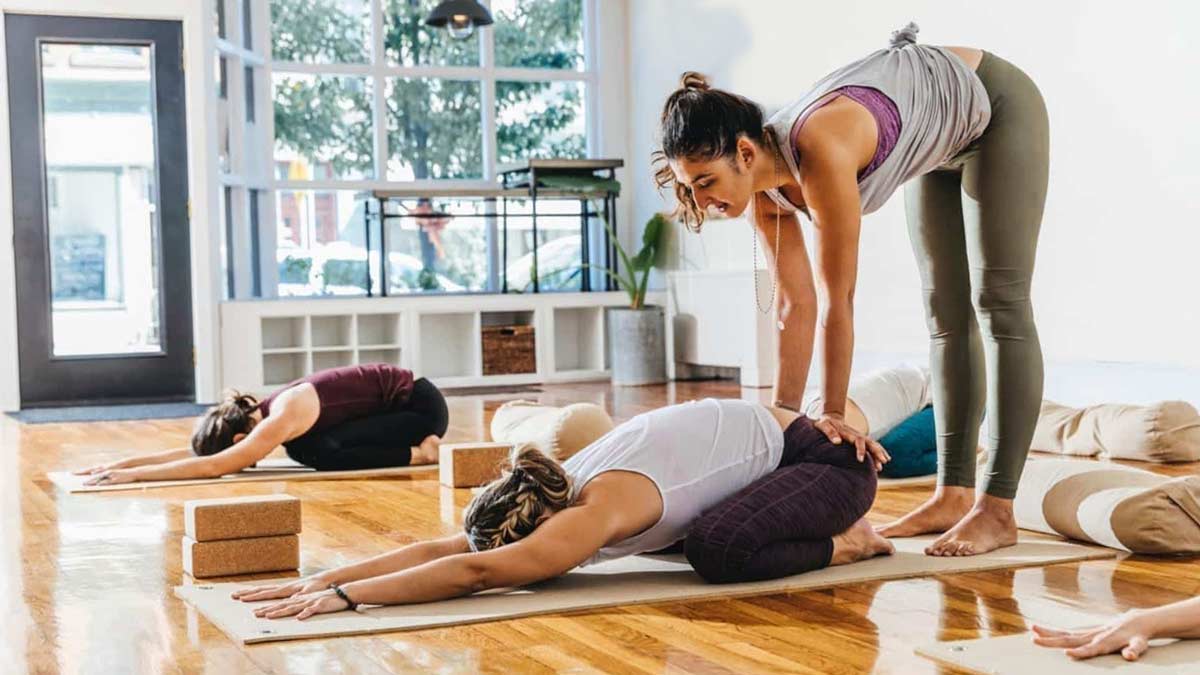HOW TO BECOME A YOGA INSTRUCTOR: FROM TRAINING & BEYOND
Sponsored content from our partners at beYogi

The numbers don’t lie: Around 85,000 yoga teachers have been certified in the United States and a staggering 300 million worldwide, according to a 2019 report by Yoga Journal and Yoga Alliance. Just as the number of teachers is growing, so are the number of students interested in this often life-changing practice. Another survey in 2019 by Yoga Alliance estimated around 38.4 million Americans alone practice yoga.
Once you get called to sit in the teacher’s seat, you may wonder how to become a yoga instructor. There are many steps to work through as you begin this journey, which will be both challenging and rewarding for you and all the students you lead throughout your time as a teacher.
1. Understanding the Role of a Yoga Instructor
Before I completed yoga teacher training, I honestly thought being a yoga instructor involved just getting people in postures. I had no idea! The reality is that yoga instructors not only cue students through physical movements, but they also hold space for their emotional, spiritual, and personal development.
That said, the main role of a yoga instructor is to provide a caring and supportive environment for students to investigate and strengthen the connections between their minds and bodies. You must offer a safe space, through mindful cueing, as well as compassion and kindness. I always want my students to feel successful, even after the most challenging classes.
Yoga instructors must have excellent communication and planning skills, and they must remain aware and mindful before, during, and after each class.
They also need to be knowledgeable in what they are teaching. There are many different kinds of yoga, from yin to hot vinyasa to stand-up paddleboard yoga to chair yoga and so many more. If you are drawn to one style, you may consider additional training after your 200-hour teacher training to specialize your career path.
2. Personal Preparation
Not everyone who has completed yoga teacher training wants to learn how to be a yoga instructor, and that’s fine if you don’t want to teach. You may just want to deepen your personal practice. Assess your motivations and commitment to sharing yoga with others before you plan to teach. When you know your “why,” you’ll be more likely to overcome any obstacles on your path to the teacher’s seat.
I personally practiced yoga for more than 10 years before becoming a teacher 13 years ago, but all you need is a strong personal practice and experience to be prepared. It’s also important to feel physically able as well as mentally able. If you’re struggling in your life, it might not be a good time to learn how to be a yoga teacher.
3. Choosing the Right Yoga Teacher Training Program
The biggest decision you’ll need to make is choosing the yoga teacher training program. I encourage you to choose an accredited certification program, like those partnered with Yoga Alliance. Everyone starts with a 200-hour course, although many committed teachers go on to pursue 300-hour and even 500-hour certifications.
As you begin your research, you’ll discover a wide variety of locations, styles, instructors, and costs. You may want to go to a destination and complete the training through an intensive three-week course, or your schedule may be better able to fit in a local course that stretches over 12 weeks or even a year. My advice is to not rush your training. Yoga teaching requires a lifetime of learning, and it can take time to integrate new concepts into your daily life and practice.
Learn more about the options with our Yoga Teacher Training Guide.
4. The Yoga Teacher Training Experience
I was right in that yoga teacher training would provide the practical steps instructors need to get students into safe postures, but that’s just the beginning of the experience. Topics in a good training program will include:
- Anatomy
- Spiritual philosophy, including reading texts like the Yoga Sutras and the Upanishads
- Proper sequencing and structure of classes
- Ethics
- Professional business and marketing strategies
This material will take as many hours as the course states: 200, 300, or 500. But as I mentioned, these hours can be packed into a few weeks or spread out over a year. These hours don’t include homework, and there will be lots to study! If you’re like me, you’ll find great joy in learning about yoga.
Yoga teacher training also always includes practice teaching with feedback from your instructors. It can be challenging to receive criticism, but it will help you be a better yoga instructor. Make sure to build a supportive community and network with your fellow trainees to lean on when the training gets challenging.
5. Obtaining Certification
To receive your certification, you’ll need to complete the required hours of training with one accredited school. This will likely include a written exam as well as leading your first yoga practice for the rest of the class. It’s a big accomplishment to complete this process, and you should be proud when you do!
Next, you’ll likely want to register with Yoga Alliance or another certifying agency as a yoga instructor. This will let your future employers know that you’re a professional who will uphold proper ethics.
Once you start teaching, you may consider adding on additional certifications. These can include continuing education in general yoga teaching or specialties. For example, I am certified in teaching chair yoga and SUP yoga, and I’m considering a certification in yin yoga. Keep learning along whatever path brings you the most passion and excitement.
6. Get Yoga Teacher Insurance
Even before your first class, look into getting yoga teacher insurance. The last thing you want is for someone to injure themselves in one of your classes, but it happens. It’s better to be prepared and covered with professional liability insurance.
Check out beYogi’s insurance coverage, as it’s a popular option with yoga instructors. You can sign up online in just a matter of minutes. It’s easy to choose from a list of yoga styles you plan to teach and coverage limits for your financial situation. You can also get umbrella coverage for a variety of bodywork and beauty practices that many yoga instructors add to their resume.
Plus through YOGA♥ Magazine you can get $20 off a professional insurance membership when you use our affiliate link.
7. Building Your Yoga Teaching Career
Once you have completed a 200-hour yoga teacher training, are certified, and insured, you’re ready to find a class! One of the best ways to do this is to simply sign up for classes at the studios, gyms, community centers, and online platforms that interest you. Talk with the owners and ask about availability in their schedule.
Create a resume with your training and interests. With time, you will have a portfolio of classes and a strong network within your local yoga community to help you find better opportunities.
Popular yoga teachers also market themselves on social media, but that’s just the start. You need to have a website, a logo, and a consistent style for your advertisements. If you are insured through beYogi, you actually get a free website as an added benefit to help you market yourself professionally.
Always look for new avenues to expand your reach to new students. Eventually, you’ll have a class of people who resonate with your style. It may take time but keep persisting.
8. Continuing Education and Professional Development
Teaching yoga can be a hobby, or it can be a career. You get to decide! The best yoga instructors, though, invest in their skills through ongoing learning and professional development.
Look for workshops, retreats, and advanced training opportunities that interest you. Stay up to date with trends in the industry and new practices. When you keep a “beginner’s mind,” you make it easier for your students to do so, too.
But yoga isn’t like other careers; instructors must invest in their personal development as well. Yoga teachers need to maintain a regular personal practice and take care of their needs. This can range from getting enough sleep to eating well to working with a psychologist. The more centered and content you are, the better you’ll be as a teacher.
9. Challenges And How to Overcome Them
One time when I was teaching preschool yoga, one of my students accidently went to the bathroom on his mat. They don’t teach you what to do then in yoga teacher training!
You’ll discover many obstacles during your training and in the following years as a teacher. Here are a few challenges (and solutions!) that I’ve experienced or learned about from my fellow instructors.
Challenge: No one comes to your class!
Solution: Have faith that you will find your students with time. You’ll learn your market and the desires of potential students, and you can adjust when necessary. Stay flexible on and off the mat!
Challenge: A more popular yoga teacher scheduled a class at the same time as yours.
Solution: Instead of comparing yourself with more seasoned yoga teachers, engage them as mentors. Consider offering a completely different style of practice: If they teach hot vinyasa, offer a yin class.
Challenge: A student might say something hurtful. One time a student actually told me he hated me for offering so many chaturangas!
Solution: Smile. Their practice isn’t about you, even if they think it is. It’s about them. If they are mindless in their speech, demonstrate extra compassion.
Challenge: You’re burned out. You may have committed to too many classes a week.
Solution: It’s crucial to make time for self-care and know when you’ve taken on too much. If you’re having trouble staying motivated or inspired, go back to the basics: Talk to the yoga teachers who ran your training or another instructor you respect. Reach out for help.
Challenge: You love teaching, but you’re simply not making enough money to pay the bills.
Solution: Depending on your location, the popularity of your classes, and whether you’re teaching in a gym or a dedicated studio, your pay can vary dramatically. Don’t be afraid to talk with your employers about pay and be ready to change locations if you can earn more.
Think of each hurdle as a necessary learning opportunity, because that’s exactly what it is.
10. Beyond Teaching: Expanding Your Career
Finally, this article on how to become a yoga instructor wouldn’t be complete without discussing all the complementary ways that you can leverage your training to enhance your career. The best-paying opportunities are private classes, workshops, and hosting retreats. Once you are confident in your teaching, you can expand and earn more.
You can also expand your career through specialization, such as therapeutic or prenatal yoga. I earned a lot more working as a standup paddleboard yoga instructor than I did teaching a more traditional class at the local gym, in part because SUP yoga requires additional training. Consider specialization as an investment in your future as a yoga teacher.
You can also use your knowledge like I do, as a professional writer! Not only do I teach four classes a week in my community, but I also enjoy writing, blogging, and creating online content. Not only is it possible to make additional income, but you can also use your work to market your teaching to more students.
And that’s really just the beginning. As you gain experience, you may want to lead your own yoga teacher training program. Maybe you have an idea for yoga-themed products, such as journals, straps, clothing, or even aromatic sprays.
Once you become a yoga teacher, you’ll have many opportunities to grow as a professional — and as a person.
